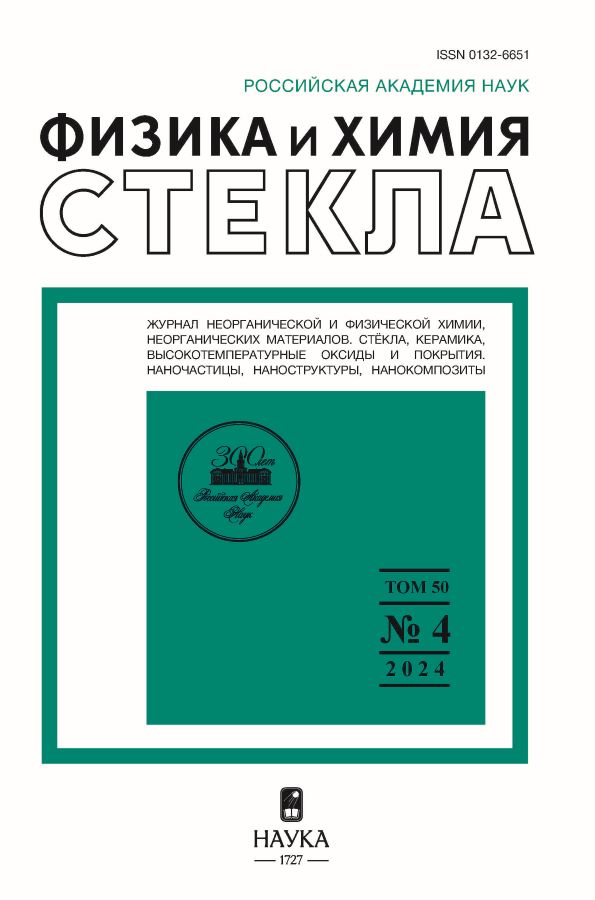Влияние способа получения на характеристики поверхности наночастиц SiO2 и Al2O3
- Authors: Мякин C.В.1, Сызранцев В.В.2
-
Affiliations:
- Санкт-Петербургский государственный технологический институт (Технический университет)
- Грозненский государственный нефтяной технический университет им. академика М.Д. Миллионщикова
- Issue: Vol 50, No 4 (2024)
- Pages: 427-434
- Section: Articles
- URL: https://rjonco.com/0132-6651/article/view/681528
- DOI: https://doi.org/10.31857/S0132665124040072
- EDN: https://elibrary.ru/QBQMXV
- ID: 681528
Cite item
Abstract
Методами адсорбции кислотно-основных индикаторов и динамической рН-метрии изучены кислотно-основные свойства поверхности наночастиц SiO2 и Al2O3, полученных различными способами. Проанализировано влияние используемых методов синтеза (включая жидкофазные и плазмохимические процессы, а также электровзрыв) на функциональный состав поверхности исследуемых материалов (преобладание кислотных или основных центров Льюиса или Бренстеда с различными значениями pKa) и свойства суспензий, получаемых с использованием синтезированных нанопорошков.
Full Text
About the authors
C. В. Мякин
Санкт-Петербургский государственный технологический институт (Технический университет)
Email: vvveliga@mail.ru
Russian Federation, 190013, Санкт-Петербург, Московский просп. 24-26/49, литер А
В. В. Сызранцев
Грозненский государственный нефтяной технический университет им. академика М.Д. Миллионщикова
Author for correspondence.
Email: vvveliga@mail.ru
Russian Federation, 364024, Грозный, просп. Исаева, 100
References
- Bailey E.J., Winey K.I. Dynamics of polymer segments, polymer chains, and nanoparticles in polymer nanocomposite melts: A review. Progress in Polymer Science. 2020. V. 105 № 7. P. 101242. doi: 10.1016/j.progpolymsci.2020.101242
- New materials: preparation, properties and applications in the aspect of nanotechnology. New York: Nova Science Publishers Inc. 2020. 247 p.
- Grammatikopoulos P., Steinhauer S., Vernieres J., Singh V., Sowwan M. Nanoparticle design by gas-phase synthesis. Advances in Physics:X, 2016. V. 2. P. 1–20. doi: 10.1080/23746149.2016.1142829
- Kaabipour S., Hemmati, S. A review on the green and sustainable synthesis of silver nanoparticles and one-dimensional silver nanostructures. Beilstein J. Nanotechnol. 2021. № 12. pp. 102–136. https://doi.org/10.3762/bjnano.12.9
- Syzrantsev V.V., Arymbaeva A.T., Zavjalov A.P., Zobov K.V. The nanofluids’ viscosity prediction through particle-media interaction layer. Materials Physics and Mechanics. 2022. V. 48. № 3. P. 386–396. doi: 10.18149/MPM.4832022_9
- Venerus D.C., Buongiorno J., Christianson R. et al. Viscosity measurements on colloidal dispersions (nanofluids) for heat transfer applications. Applied Rheology 2010. V.20. № 4. С. 44582.
- Minakov A., Rudyak V., Pryazhnikov M. Systematic Experimental Study of the Viscosity of Nanofluids. Heat Transfer Engineering. 2021. V. 42. № 12. P. 1024–1040.
- Lysenko, V.I., Emelkin, V.A., Anisimov, A.G., Mali V.I. Microhardness of ceramics produced from different alumina nanopowders by different techniques. Inorganic Materials. 2014. Т. 50. № 5. С. 537–540.
- Syzrantsev V.V Variation of properties of composite with nanoparticles of different origins // Tsvetnye Metally 2023. Issue 8. P. 34 – 38.
- Танабе К. Твердые кислоты и основания. М.: Мир. 1973. 156 с.
- Chukin G.D., Smirnov B.V., Malevich V.I. Formation of the structure of an amorphous aluminosilicate catalyst and its Lewis acid sites. Kinetics and Catalysis 1988. V. 29. № 3. Р. 609 – 615.
- Сычев М.М., Минакова Т.С. Кислотно-основные характеристики поверхности твердых тел и управление свойствами материалов и композитов. Санкт - Петербург : Химиздат, 2022. 288 с.
- Khavryuchenko V.D., Sheka E.F. Computational modeling of amorphous silica. 4. Modeling the initial structures. Aerogel. J. Structural Chem. 1994. V. 35. № 3. Р. 305–308. https://doi.org/10.1007/BF02578281
- Sheka E.F., Khavryuchenko V.D., Markichev I.V. Techonological polymorphism of disperse amorphous silicas: inelastic neutron scattering and computer modelling. Rus. Chem. Rev. 1995. V. 64. № 5. P. 389–414. https://doi.org/10.1070/RC1995v064n05ABEH000156
- Svitkova B., Zavisova V., Nemethova V. et al. Differences in surface chemistry of iron oxide nanoparticles result in different routes of internalization. Beilstein J. Nanotechnol. 2021. № 12. Р. 270–281.
- Vollath D., Fischer F.D., Holec D. Surface energy of nanoparticles – influence of particle size and structure. Beilstein J Nanotechnol. 2018. № 9. Р. 2265–2276. doi: 10.3762/bjnano.9.211
- Morterra, G., Bolis, C., Magnacca, V. IR Spectroscopic and Microcalorimetric Characterization of Lewis Acid Sites on (Transition Phase) Al2O3 Using Adsorbed CO. Langmuir. 1994, V. 10. № 6. Р. 1812–1824. https://doi.org/10.1021/la00018a033.
- Нечипоренко А.П. Донорно-акцепторные свойства поверхности твердофазных систем. Индикаторный метод. Изд. «Лань», 2017, 284 с.
- Сычев М.М., Минакова Т.С., Слижов Ю.Г., Шилова О.А. Кислотно-основные характеристики поверхности твердых тел и управления свойствами материалов и композитов. СПб.: Химиздат, 2016. 276 с.
- Finlanson M.F., Shah B.A. The influence of surface acidity and basicity on adhesion of poly (ethelene-coacrylic acid) to aluminum. J. Adhes. Sci. Technol. 2012. V. 4. № 1. Р. 431–439.
- Syzrantsev V.V. Analysis of variation in the properties of the surface of SiO2 and Al2O3 nanoparticles obtained by different methods. Kondensirovannye sredy i mezhfaznye granitsy (Condensed Matter and Interphases), 2022, 24(3): 369–378.
- Syzrantsev V.V., Mjakin S.V., Katashev P.A. Comparative study of surface acid-base properties of SiO2 and Al2O3 nanoparticles prepared by different methods. Glass Physics and Chemistry. 2022. V. 48. № 6. Р. 636–641. doi: 10.1134/S1087659622800082
- Bardakhanov, S.P., Vasiljeva, I.V., Kuksanov, N.K., Mjakin, S.V. Surface functionality features of nanosized silica obtained by electron beam evaporation at ambient pressure. Adv. Mater. Sci. Eng. 2010. № 241695. Р. 5. doi: 10.1155/2010/241695.












